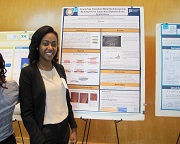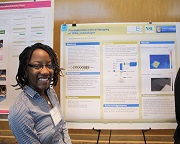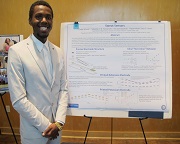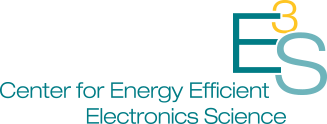2016 UCB-HBCU Program Participants and Projects
 Undergraduate Researcher: Tsegereda Esatu
Undergraduate Researcher: Tsegereda Esatu
Major: Electrical Engineering
Home Institution: Jackson State University
Research Project: Crack-Free Transition Metal Dichalcogenide Monolayers for Large-Area
HBCU Faculty Advisor: Prof. Mohammad A. Khan
UC Berkeley Faculty Advisor: Prof. Ali Javey
Postdoctoral Mentor: Dr. Sujay Desai
Hosting Organization: Department of Electrical Engineering and Computer Science, University of California, Berkeley, CA
Abstract: Two dimensional (2D) materials like MoS2 have attracted immense interest for application in electronic and optoelectronic devices. Tape exfoliation of 2D materials like graphene results in very small (≈5 μm) size flakes. Gold mediated exfoliation on the other hand yields ultra large (≈500 μm) size MoS2 monolayer flakes. These flakes however may be prone to cracking. Here, we describe techniques to optimize the gold-exfoliation process to produce ultra-large monolayers with even surfaces and less cracks. Selective decoration of edges, cracks, and grain boundaries with gold nanoparticles and atomic-force microscopy (AFM) are used to ascertain the quality of exfoliated flakes. Several approaches are employed to reduce cracks. These include changing the thickness of the evaporated gold film, using other metals for exfoliation (Ag, Pd, etc.), replacing adhesive tapes used for the gold-exfoliation, and annealing of the evaporated gold. This process provides high quality, large, crack-free exfoliated monolayers which can be used for large-area electronics.
Project poster
 Undergraduate Researcher: Essence Hansberry
Undergraduate Researcher: Essence Hansberry
Major: Electrical/Electronic Engineering
Home Institution: Norfolk State University
Research Project: Photoluminescence Imaging of WSe2 Monolayer
HBCU Faculty Advisor: Prof. Patricia Mead
UC Berkeley Faculty Advisor: Prof. Ming Wu
Graduate Student Mentor: Kevin Han
Hosting Organization: Department of Electrical Engineering and Computer Sciences, University of California, Berkeley
Abstract: Photoluminescence is the emission of light from a material due to photoexcitation. A setup has been constructed to measure the amount of photoluminescence found in a sample of Tungsten Diselenide (WSe2). WSe2 is used because it can be injected with electrons and holes. When the electrons and holes recombine, the electrons emit their energy as light, which is then projected onto a spectrometer that will create a graph which will display how much photoluminescence is produced by the sample. Its monolayers are useful because they display bright photoluminescence and can enhance optoelectronic. The overall purpose of this research is to determine the monolayer’s efficiency.
Project poster
Undergraduate Researcher: Paige Harvey
 Major: Electrical Engineering and Computer Science
Major: Electrical Engineering and Computer Science
Home Institution: Morgan State University
Research Project: Wireless Infrared Receiver Design
HBCU Faculty Advisor: Prof. Michel Reece
UC Berkeley Faculty Advisor: Prof. Ali Niknejad
Graduate Student Mentor: Filip Maksimovic
Hosting Organization: Department of Electrical Engineering and Computer Science, University of California, Berkeley
Abstract: At the University of California Berkeley, there has been a recent decline in student’s interest in majoring in Electrical Engineering as opposed to Computer Science, whereas 20 years ago this was the exact opposite. On Berkeley’s campus, the Electrical Engineering and Computer Science departments start off running parallel to one another, leading professors to believe the introductory courses to be at fault for this shift in interest. The shift is believed to be attributed to student’s lack of a firm understanding of “what Electrical Engineering is” when exiting their introductory classes. Therefore, they proposed integrating a new project into the curriculum in hopes of regaining attention and overall student interest thus, making Electrical Engineering more attracting to Berkeley’s students.
Project poster
Undergraduate Researcher: Caleb Woods
Major: Electrical Engineering
Home Institution: Hampton State University
Research Project: Printed and Flexible Sensors for Potassium Monitoring in Sweat (Sweat Sensors)
HBCU Faculty Advisor: Prof. Otsebele Nare
UC Berkeley Faculty Advisor: Prof. Ana Claudia Arias
Postdoctoral Mentor: Dr. Natasha A. D. Yamamoto
Hosting Organization: Department of Electrical Engineering and Computer Science, University of California, Berkeley
Abstract: The levels of lactate, sodium, potassium, and ammonium within human sweat can be used to glean information about the overall condition of the person sweating. The goal is to create a fully flexible, wearable sweat sensor that will be able to give real-time information on a person while they do physical activity. Using perspiration as a reference point for wearable biosensors is an example of non-invasive technology being used to greater potential in terms of the ease at which we can monitor health indicators. The sweat is probed for information by using different working electrodes that can detect each specific compound and reference the potential against a reference electrode giving a small voltage for each. This project will continue Prof. Ali Javey’s work on wearable sensor arrays and take it one step further by using fully flexible material on the entire apparatus, including the circuit board (excluding circuit components) and aims to create a final, flexible, wearable sensor array that can additionally monitor the concentration of ammonium within one’s sweat. The sensor must be able to simultaneously monitor each of the previously mentioned metabolites while communicating the data to a phone.
Project poster
